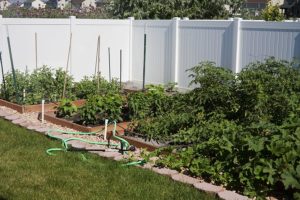
A microclimate is a small area with slightly different temperature or climate than the surrounding larger area. Every garden has microclimates; microclimates can be created by hills and low spots, structures and fences, and even the shade of trees or tall plants.
You can use the microclimates in your garden to help vegetables produce a little bit better—a little faster, a little bigger, even a little tastier.
Here’s how to understand your garden’s microclimate:
Map the microclimates in your garden by noting where the sun shines most, where shadows fall and when and where breezes blow and where they don’t. Look for natural low and high spots that may stay cooler or warmer than the surrounding area. In the cool time of the year, note where patches of snow and frost disappear first and where they linger.
Take into consideration surrounding structures—a house, a shed, fences, or walls. Wood and stone structures absorb the sun’s heat during the day and release it back into the garden at night. Gardens on the south and west side of structures get the most sun each day and will warm more quickly. An east-facing garden will get the first sun each day, but can be in shadows by afternoon. North facing gardens get the least sun and stay cooler year round. North-facing slopes are cooler than south-facing slopes which also will be drier.
Cold air moves to the lowest spot in a garden—expect cool temperatures and frost to linger in low spots. A fence without an opening at the bottom of a slope can trap cold air.
Wind and breezes will increase heat loss in a garden. Winds can stress plants and slow down their development; too much wind can dessicate plants. Look for natural windbreaks when planning a garden—trees and trees lines, large shrubs and hedges that keep winds from reaching vegetable planting beds and drying them out. Consider planting natural windbreaks when planning your garden.
How to alter microclimates to benefit vegetable crops:
Locate your vegetable garden where it is not shaded by buildings or trees. Place the garden at least 20 feet away from tall trees that will cast shadows and compete for water and nutrients.
Avoid low spots that are slow to dry in the spring. Cold air will collect in these spots.
On slight slopes run rows at right angles to the slope so that each crop gets maximum sun exposure. Where slopes are steep let rows follow the contour or terrace the garden.
Crops that thrive on heat such as tomatoes, peppers, eggplants, and beans should be planted in south-facing or west-facing gardens or in rows that run north and south. Heat-loving crops can be planted close to walls and fences that absorb heat during the day and reflect it back into the garden at night.
Use stone, brick, and gravel pathways to capture the sun’s heat during the day and release it slowly into the garden at night. Stone and gravel paths can surround mounded or raised beds for crops that demand warmth and heat.
Create a thermal mass for crops to change the microclimate and aid plant growth; gallon milk containers filled with water can soak up the sun’s warmth in the day and keep plants warm at night.
Where gardens are exposed to breezes and winds, create natural windbreaks by planting dense trees such as conifers or create seasonal windbreaks by planting sunchokes, sunflowers, or corn on the windward side of the garden. If planting is not an option, create windbreaks for individual plants by propping up shingles, sheets of plastic, or staking bottomless sacks around plants.
Use cooler and warmer spots in the garden to your advantage. Cool and shady areas can be planted with salad greens and root crops during the summer. Interplant crops averse to too much sun or heat in the shadows of taller crops.
Attach shade cloth or lattice to hoops or frames above crops that want cooler temperatures during the summer. Plant leafy crops in east-facing gardens during the summer; they will be shaded in the warmest part of the day.
Review your garden’s microclimate map each season to see if there have been changes.



